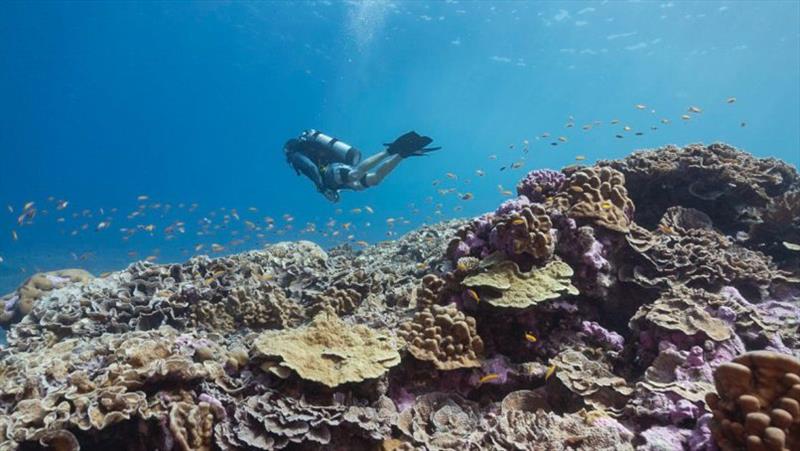
Surviving extreme heat
by WHOI 21 Aug 2021 15:52 UTC

WHOI post-doctoral scientist Michael Fox surveys a coral reef on Kanton in the northern PIPA that survived intense heatwave of 2015. The team returns to Kanton in 2022 to study the processes that facilitated survival of this reef and others in the PIPA © Richard Brooks, Lightning Strike Media / WHOI
A team led by Anne Cohen, a scientist at Woods Hole Oceanographic Institution, received $1.75M in funding from the National Science Foundation (NSF) to study how coral reefs survive extreme heat events caused by climate change.
The multidisciplinary project taps into expertise across four WHOI departments to uncover the oceanographic and biological processes that enable corals to survive marine heatwaves.
Coral reefs provide habitat for a quarter of all known marine species and support the livelihoods of a billion people worldwide. But coral reefs everywhere are dying at an alarming rate. Climate change is warming the oceans and as a consequence, marine heatwaves have increased in frequency and intensity. Water temperatures just 1 degree Celsius above normal can cause corals to bleach, but recent heatwaves have far exceeded that threshold in many areas. Indeed, in just the last 4 decades, millions of corals have died, and entire coral reefs have been extinguished due to ocean warming.
The Phoenix Islands Marine Protected Area (PIPA), an oceanic wilderness in the remote tropical Pacific, was established by the island nation of Kiribati in 2006 to protect over 408,000 km2 of ocean habitat, including coral reefs, seamounts and terrestrial ecosystems. Here, in the bullseye of the strongest marine heatwaves, PIPA's reefs have an inspiring story to tell of adaptation and resilience. According to Cohen and her fellow investigators, many of PIPAs corals succumbed to intense bouts of heat that hit the region in 2002, 2009 and again in 2015. But their data shows some reef areas, each spread across thousands of square meters and hosting a diversity of coral species, did survive and likely played a critical role in the recovery of PIPA's corals.
"Coral reefs are beautiful, magical places, but they are also incredibly important to humanity. Even in the United States, our coral reefs provide hundreds of thousands of jobs and protect strategic military infrastructure. But now, coral reefs are in crisis because of climate change. The sense of urgency is so great that scientists, conservation organizations and governments of coral reef nations are pulling together to try tackle it, and WHOI is playing a vital role," said Cohen.
Cohen and WHOI scientists Michael Fox, Weifeng (Gordon) Zhang, Simon Thorrold, Steven Lentz, and Nathaniel Mollica, and MIT-WHOI graduate student, Phadtaya 'Pad' Poemnamthip will test the hypothesis that coral resilience to extreme heat is ultimately rooted in the dynamic reef environment. Combining sensors deployed on the reefs with sophisticated hydrodynamic models, they show that water temperature and flow in and around coral reefs is highly variable over small spatial scales and dramatically different from that of the open ocean that surrounds them. This fine-scale mosaic of environmental conditions sets the stage for coral survival in two main ways. In areas on the reef where waters are naturally and chronically warmer than the open ocean, corals have the opportunity to genetically adapt to higher temperatures. Conversely, in other areas on the reef where cool water may be episodically upwelling from the deep, corals are able to shelter from the heat.
"This achievement was possible because of WHOI's long-term commitment to the PIPA, not only doing world-class science, but building relationships with Kiribati, learning from the Kiribati people, collaborating, training and sharing our findings" Cohen said. "It's not just about collecting data and zipping back to the lab. What WHOI does in the world matters. People matter."
While Kiribati observers have joined all prior expeditions to the PIPA, this award explicitly supports the participation and training of Kiribati residents and high school students. "Thanks to WHOI for its tireless efforts and support for the corals in the PIPA, and we're equally thrilled about the involvement of Kiribati students and the Kanton residents in upcoming projects. This is an important step for building local capacity in these specialized areas of marine science," said Teburoro Tito, Kiribati Ambassador to the United States, Permanent Representative to the United Nations and Chair of the PIPA Trust Board.
The WHOI team will lead two expeditions to the PIPA, sailing thousands of miles across the remote central Pacific aboard the 72-ft sailboat Seadragon, operated by the non-profit Pangaea Explorations. Combining high resolution 3-D hydrodynamic models, oceanographic observations, physiological assays, coral chemistry, and skeletal records of growth and bleaching, they will study the processes that enable PIPA's corals to survive extreme heat. This new knowledge will help scientists and coral reef managers everywhere to determine where in the world climate resilient corals exist, predict their chances of survival as the global ocean continues to warm, and identify the strongest corals for conservation and reef restoration.